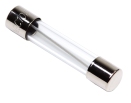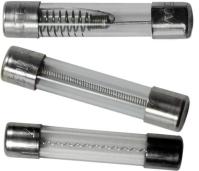This article is a fairly simple run through about fuses.
When you really look into it there are a huge number of different types of fuse many of them so specialised that you will probably never see them. These are the most basic ones.
A fuse is a device that shuts off the power to an electrical circuit when there is too much current flowing through it. This usually happens when too many appliances are plugged in or if there is a short circuit. A fuse is made as an intentional weak spot in a circuit that will melt (or “blow”) when too much current is flowing through it, shutting off the power to the rest of the circuit. After the fuse blows, the problem that caused it to blow must be corrected and the fuse must be replaced to restore power to the circuit. A circuit breaker does the same job as a fuse, but it can be reset without replacing anything.
Fuses come in different amperage ratings and lengths.
In the UK the common sizes of fuses used in domestic plugs are 1,3,5,7 and 13 amps. You can get fuse ratings in between these numbers.
The most common fuse length in UK domestic use is 25mm long. You might occasionally see a fuse that is 20mm long.
Most of the fuses above will have a ceramic or glass body with a conductive cap at each end. One of the advantages of a glass fuse is that you can see inside to see if they are ok or blown. Ceramic fuses are more robust.
A ceramic fuse A glass fuse.


Fuse Blow Speed.
These letters may be printed on the fuse body.
Category Long description
FF. Very fast-acting fuse
F. Fast-acting fuse
M. Medium speed
T. Slow Acting Fuse
TT. Very Slow Acting Fuse
The speed at which a fuse ‘blows’ depends on the material the fuse is made from.
A ‘standard’ fuse blows when the electrical current is above the fuse rating for about 0.1 seconds.
Sometimes the demands of the electrical circuit are such that a short time period of ‘over current’, say 0.5 seconds, is acceptable. The requirement is for the fuse to blow after 0.6 seconds of over current rather than 0.1 seconds. Such a fuse is called a ‘slow blow’ fuse or ‘anti-surge’ fuse.
Some electrical circuits, for instance, electrical motors, draw large current for a few seconds as the motor starts up; a fuse that doesn’t blow for four seconds is used. In this case ‘slow blow’ means four seconds.
Some electrical circuits, for instance ‘micro-electronic’ circuits, are very sensitive to over current and blow after 0.01 seconds so, when compared to the ‘standard’ blow time of 0.1 seconds, are ‘fast blow’ fuses.
Slow blow, fast blow, ultra-fast blow etc are all relative terms and are open to interpretation and mean different times in different contexts.
A selection of slow blow fuses.

Thermal fuses.
A thermal fuse is often found in consumer equipment such as coffee makers, hairdryers or transformers powering small consumer electronics devices. They contain a fusible, temperature-sensitive composition which holds a spring contact mechanism normally closed. When the surrounding temperature gets too high, the composition melts and allows the spring contact mechanism to break the circuit. The device can be used to prevent a fire in a hairdryer for example, by cutting off the power supply to the heater elements when the airflow is interrupted (e.g., the blower motor stops or the air intake becomes accidentally blocked). Thermal fuses are a ‘one-shot’, non-resettable device which must be replaced once they have been activated (blown).
Circuit breakers.
A circuit breaker is an automatically operated electrical switch designed to protect an electrical circuit from damage caused by excess current from an overload or short circuit. Its basic function is to interrupt current flow after a fault is detected. Unlike a normal cartridge fuse, which operates once and then must be replaced, a circuit breaker can be reset (either manually or automatically) to resume normal operation. They can only be reset once the problem has been corrected.
Re-settable fuses.
A re-settable fuse is made up of a non-conductive crystalline polymer matrix that is loaded with carbon black particles to make it conductive. While cool, the polymer is in a crystalline state, with the carbon forced into the regions between crystals, forming many conductive chains. Since it is conductive it will pass a current.
If too much current is passed through the device the device will begin to heat. As the device heats, the polymer will expand, changing from a crystalline into an amorphous state. The expansion separates the carbon particles and breaks the conductive pathways, causing the device to heat faster and expand more, further raising the resistance. This increase in resistance substantially reduces the current in the circuit. A small (leakage) current still flows through the device and is sufficient to maintain the temperature at a level which will keep it in the high resistance state.
The device can be said to have latching functionality.
When power is removed, the heating due to the leakage current will stop and the device will cool. As the device cools, it regains its original crystalline structure and returns to a low resistance state where it can hold the current as specified for the device. This cooling usually takes a few seconds, though a tripped device will retain a slightly higher resistance for hours, unless the power in it is weaker, or has been often used, slowly approaching the initial resistance value. The resetting will often not take place even if the fault has been removed with the power still flowing as the operating current may be above the holding current of the fuse. The device may not return to its original resistance value; it will most likely stabilise at a significantly higher resistance (up to 4 times the initial value). It could take hours, days, weeks or even years for the device to return to a resistance value similar to its original value, if at all.
Re-settable fuses.
